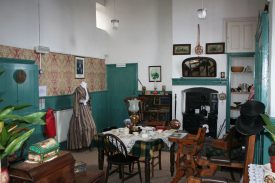After the Education Act of 1870, Newdegate was keen to keep his schools as independent as possible. He saw the new locally organised Board Schools, now being set up all over the country, as too expensive and insufficiently religious. Coton maintained its Church of England status. In 1874 a new section was added to the girls’ school building with separate accommodation for a schoolmistress. There would also be small enclosed play areas for boys and girls at the front of the building, increasingly expected in schools. A partitioning of the schoolrooms would enable more flexible teaching of larger numbers, but the principle of a large schoolroom at the heart of the teaching still prevailed.
The final improvements
The two large schoolrooms for boys and girls still dominate the shape of the building today. 1893 saw the final improvements to the building. There were new drains, fireplaces, chimney stacks, and windows. ‘Best quality local stone’ was to be used. In the boys’ school new classrooms were created including turning part of the schoolmaster’s house into a classroom, illustrating the pressure on space. More and more boys and girls now attended, often more regularly and frequently for longer.
By the early 20th Century there was a wider and more advanced curriculum, fitter pupils, a larger staff, and dedicated Head teachers such as George Mosedale ( Boys’Head 1887 -1929) and Florence Towe (Girls’Head 1911-32). Between 1880 and 1902 the role –and financing – of the Newdegates gradually declined and the local authority now took over the main, if not sole, role in the running of the school. The quality of teaching steadily improved but as numbers continued to increase the buildings were barely adequate; they were cold in winter, and often only moderately equipped.
Combined into one school
In 1932 the Boys’ and Girls’ sections combined into one school, and instead of staying on until 13 or 14 all pupils would now leave at 11 for a secondary education that their parents and grandparents had rarely enjoyed. The building of the Hill Top estate in the early 1930s kept up numbers for a time but the school’s future became questionable, especially after the war damage from the bomb that destroyed Coton Parish Church, opposite, in 1941.
The school officially closed in 1954 but the buildings were kept open to cope with an overflow of pupils from other institutions. Only in 1973, with comprehensive re-organisation, did it finally cease to take more children and it was then taken over by the local Parks department. For a time the building’s future remained uncertain and in 1987 the Borough Council planned to demolish a now neglected building.
A vision for the historic building
But in 1988, local conservationists led by Beryl Kerby had the vision of turning the historic building into a heritage centre for the area. After a lot of hard work and lobbying by many local people – including the foundation of the Nuneaton Civic Society – Beryl’s dream was realised. Over 25 years later the Heritage Centre is thriving. There are several meeting rooms for local groups and a victorian schoolroom – a brainchild of Beryl’s – where local schoolchildren can engage in hands on history as they discover the nature of 19th century education.
The centre is administered by a group of trustees who have worked hard with the aid of lottery and other grants to gradually improve the appearance of the building, still owned by the Borough Council but run and financed by local people. More and more local groups are using the centre and there are regular historical exhibitions; appropriately, these have recently included school memories of local people.
A new kitchen to provide a higher standard of refreshments has now opened, and there is a working office with volunteers. In the summer of 2011 the Centre obtained a grant for major repairs to the roof of the building to finally eliminate the damp problems inherent in old buildings. In 2011 a new roof was completed; the building is now warmer, drier and better insulated than at any time in its history.











Comments
Hi
It is my understanding that my Grandpa was Headteacher at Chilvers Coton Primary around the 1930’s plus. His name was Albert Edward Ascott but he was known as Ted. My dad who was born in Nuneaton remembers the bombing of the church and the five foot walls of the School building!
I have grandpa’s wooden baton for pointing at the blackboard! I too am now a Head of a village primary and would love to find out more.
I was born in 1958 and attended Chilvers Coton school but I’m sure it was on Coventry Road opposite a corner shop and I don’t recall it looking like the heritage centre? I remember it was a very old building, the toilet’s were outside & I think the playground was at the front of the building. When I left there, I went to Middlemarch school which was a very modern building in comparison to Chilvers Coton.
Add a comment about this page